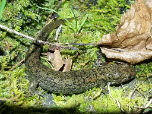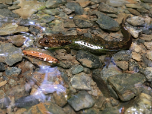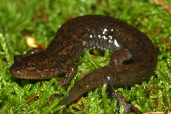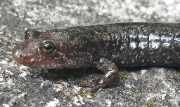Blue Ridge Blackbelly Salamander (D. mavrokoilius)
Description: Desmognathus mavrokoilius closely resembles other members of the Black-bellied Salamander complex and cannot be reliably separated using external coloration or patterning. It can be identified using molecular markers and has a set of unique mitochondrial haplotypes and fixed differences at numerous mitochondrial and nuclear loci. It is best identified in the field using its geographic range and the site locality. This species is parapatric with D. kanawha that occurs to the east, but the two have not been found to be syntopic in North Carolina at any site as of 2023. On the eastern edge of the Smokies, D. mavrokoilius is parapatric with D. gvnigeusgwotli, while on the southeastern side of the Great Balsams from Courthouse Creek northeast to Hickory Nut Gorge, it is parapatric with D. amphileucus. In general, any black-bellied salamander that is found north of the French Broad River to the Virginia border (and outside of the range of D. kanawha to the east) can be assigned to this species.
Like other members of the Black-bellied Salamander complex, D. mavrokoilius is a large, stocky Desmognathus with a black belly and usually two rows of light dots along each lower side of the body. The keeled tail is laterally compressed, and the toe tips are black and cornified. This species is relatively small (maximum size of the adults ca. 83 mm SVL).
Habitat: In or along swift, boulder-strewn mountain streams. Also near waterfalls and places where cold water drips or seeps. Refuges are in rock cevices or in burrows. Usually under rocks in daytime. Sometimes basks in sun on wet rocks. Eggs are laid on undersides of rocks or on tree roots in streambed, apparently in headwater tributaries in North Carolina.
Range: In the Blue Ridge Mountains, from the eastern margin of the Great Smoky Mountains and the southeastern versant of the Great Balsam Mountains north to approximately Mt. Rogers (extreme west-southwest Virginia southwest through montane western North Carolina and montane eastern Tennessee almost to the South Carolina line.
Found in these States:
NC |
TN |
VA
Diet: Eats insects, snails, and small salamanders; aquatic prey dominate diet of larvae; adults eat substantial amounts of both aquatic and terrestrial prey. Largely an ambush predator.
Reproduction: Lays up to about 60 eggs in June-July, singly or in cluster. Female remains with eggs until hatching. In Virginia, aquatic larvae hatched in August-September, metamorphosed in 2 years; larval period was 3-4 years (sometimes 2 years) in North Carolina. In northeastern Georgia, hatching occurred in July, and the larval period lasted 3 or 4 years, depending on location. In North Carolina, age of first reproduction was estimated at 9-10 years in females and 7-8 years in males.
Status: No Status rank as this anuimal was just newly moved to species level.
»» Kingdom: Animalia - Animals
»» Phylum: Chordata - Chordates
»» Subphylum: Vertebrata - Vertebrates
»» Class: Amphibia - (Amphibians)
»» Order: Caudata - Salamanders
»» Family: Plethodontidae - Lungless Salamanders
»» Subfamily: Hemidactyliinae - Hemidactyliine Salamanders
»» Genus: Desmognathus
»» Species: Desmognathus mavrokoilius - Blue Ridge Blackbelly Salamander
This article uses material from the Wikipedia article "Blackbelly Salamander", which is released under the Creative Commons Attribution-Share-Alike License 3.0. Content may have been omitted from the original, but no content has been changed or extended.
|








